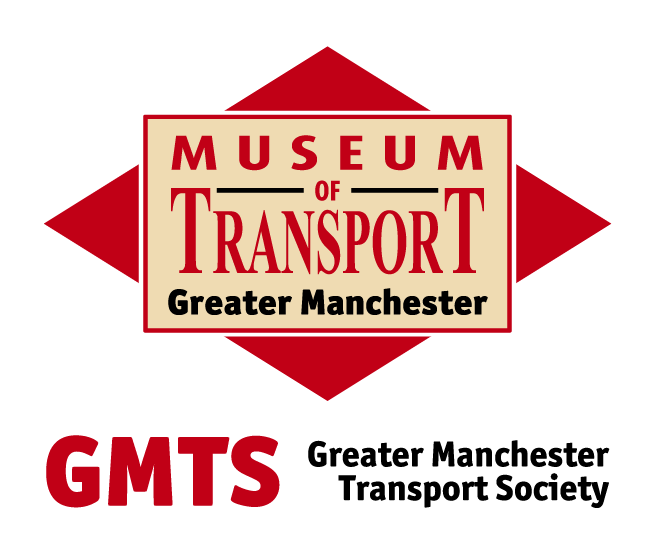1914 Total passengers carried annually by Manchester Corporation exceeds 200 million for the first time.
1914 Great Britain declares war on Germany as part of the First World War (4 August) - effectively preventing further tramway expansion.
1914 War Office requisitions Manchester Corporation’s eight motor buses for military purposes. Horse omnibuses reinstated in substitution (August).
1914 LUT’s second attempt at motor bus operation using three charabancs, which are quickly requisitioned by the War Office.

Salford Corporation’s Frederick Road Tram Depot, before the construction of the entrance arch
1915 Conductresses (female conductors) are employed by Manchester Corporation for the first time due to the shortage of staff because of the First World War.
1915 Holt Brothers of Rochdale commences motor coach operation.
1918 2,917 Manchester Corporation employees join H.M. Forces in the First World War (of which over 300 lost their lives).
1918 First World War ends (11 November).
1918 Backlog of maintenance and wartime neglect of the tramways has to be remedied.
1919 Manchester Corporation’s weekly working hours for employees reduced to 48.
1919 Motor buses withdrawn by Oldham Corporation.
1919 Last trolleybuses are operated by Stockport Corporation, replaced by motor buses.
1919 LUT’s third and successful attempt at motor bus operation, between Lowton and Newton-le-Willows.
1919 Ribble Motor Services commences bus services.
1919 Wigan Corporation introduces experimental motor bus services (October).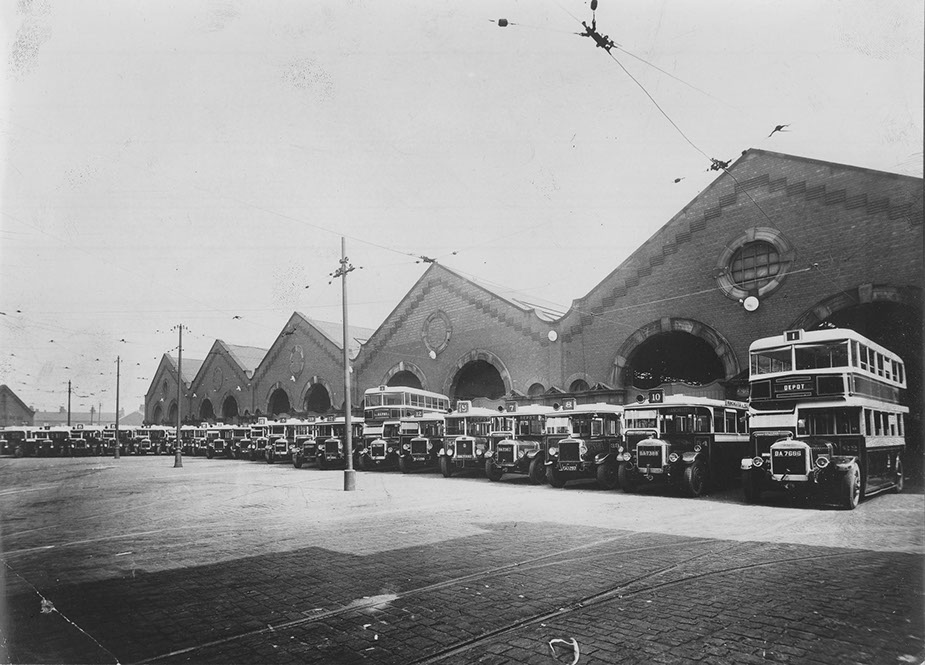
This is Salford Corporation's Frederick Road Garage showing the ever growing new fleet of buses
1920 First Salford Corporation motor bus service (July).
1920 Royal Assent given to allow Leigh Corporation to operate buses (4 August).
1920 Leigh Corporation starts its first motor bus service, garaged in the fire station originally (November).
1920 The British Automobile Traction Company (BAT) starts operating services in Buxton and Stockport, under the name “British”.
1920 A Mayne & Son starts operating bus services.
1921 Superannuation scheme commences for Manchester Corporation’s employees.
1921 Ashton-under-Lyne Corporation takes over the Oldham, Ashton and Hyde tramway operations.
1921 First Wigan Corporation motor bus service commences.
1921 SHMD takes over its section of the Oldham, Ashton and Hyde Tramway Company’s operations allowing through services between Manchester and Hyde.
1922 First one-man operated motor buses introduced by Manchester Corporation between Chorlton and Longford Park.
1922 Wigan Corporation discontinues its experimental motor bus services (15 October).
1922 Manchester Corporation extends Princess Road tram depot to increase capacity.
1923 Motor bus services introduced to act as feeder services to tramway systems in Greater Manchester.
1923 Railway Grouping into the ‘Big Four’ – local services are now provided by the newly formed London, Midland and Scottish Railway.
1923 Ashton-under-Lyne Corporation’s first experimental motor bus service begins, to Smallshaw Lane (February).
1923 Bolton Corporation resumes motor bus services.
1923 North Western Road Car Company incorporated, owned by Thomas Tilling Limited and BAT (23 April).
1923 Ramsbottom Corporation introduces its first motor bus services (August) between Edenfield and Rawtenstall Station.
1923 Wigan Corporation temporarily operates motor bus services.
1924 Stockport Corporation opens new tram depot on Heaton Lane (January).
1924 Total passengers carried annually by Manchester Corporation exceeds 300 million for the first time.
1924 Last tramway extension by Bolton Corporation opens.
1924 Motor buses reintroduced by Oldham Corporation.
1924 North Western’s head office moves from Macclesfield to Charles Street, Stockport and it starts bus operations in Oldham.
1924 Ribble applies to operate bus services in Ramsbottom.
1924 Work starts on Bolton Corporation’s Breightmet Street Garage (October).
1924 North Western takes over Mid Cheshire Motor Bus Company (November).
1924 Wigan Corporation resumes motor bus services (30 November).
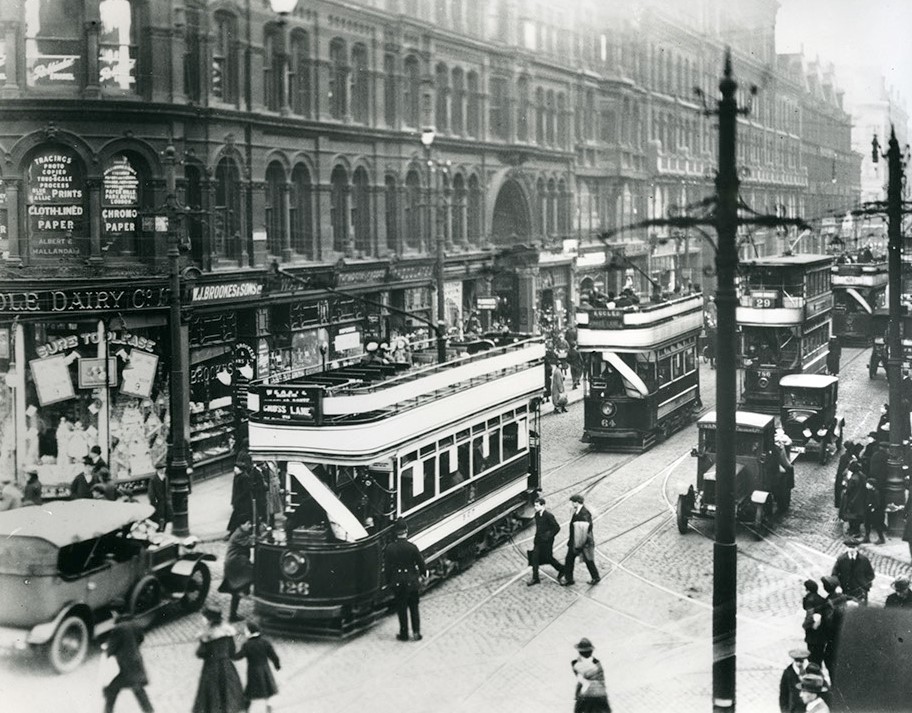
Busy shopping street Deansgate in Manchester, showing Manchester and Salford corporation trams
1925 Middleton Electric Traction Company acquired by Middleton, Rochdale and Oldham corporations - Middleton leases its routes to Manchester Corporation for operation.
1925 Wigan Corporation starts operating trolleybuses (7 May).
1925 First trolleybus service operates between Ashton-under-Lyne and Oldham by Oldham and Ashton corporations, soon withdrawn and replaced by trams on the Hathershaw to Oldham section (August).
1925 First motor buses operated by Bury Corporation, on the Walshaw service (18 September).
1925 First SHMD motor bus service begins.
1926 First motor buses introduced by Rochdale Corporation, to Deeplish (17 March).
1926 Parrs Wood garage, with accommodation for 50 motor buses, opened by Manchester Corporation - its first purpose built bus garage.
1926 Public transport is paralysed by the General Strike.
1926 Lancashire United Tramways Limited becomes Lancashire United Transport and Power Company Limited.
1926 Last tramway extension by Oldham Corporation, to Middleton.
1926 North Western opens its new central workshops at Charles Street, Stockport.
1927 First express cross-city joint bus services introduced to compete with private operators (April).
1927 First pooling arrangements of buses between Bury, Ramsbottom and Rawtenstall corporations to allow a coordinated service between the three operators.
1927 Last tramway extension by Wigan Corporation.
1927 SLT extends Hindley tram depot at Platt Bridge.
1927 Glossop Corporation’s tramway system is abandoned.
1927 Holt Brothers of Rochdale now operates Yelloway long distance motor coach services
1928 Manchester Corporation opens Birchfields Road Tram Depot (24 July) and extends Hyde Road Car Works.
1928 Manchester Corporation converts its buses from solid to pneumatic tyres.
1928 Top covers are fitted to the upper decks of Manchester Corporation’s buses.
1928 On Manchester Corporation’s all-night services, buses substitute for tramcars on some routes.
1928 Manchester Corporation opens the first part of the new Queens Road bus garage (now part of the Museum of Transport).
1928 Decision made by Oldham Corporation to abandon its tramways.
1928 First tram route abandoned by Wigan Corporation and converted to motor bus operation.
1928 North Western Road Car Company and Ribble Motor Services become major shareholders in Omnibus Stations Limited, resulting in the construction of Lower Mosley Street Bus Station.
1928 Henry Mattinson (General Manager of Manchester Corporation Tramways Department) and Ernest Tilly are granted a patent for a ticket machine produced by Brecknell Munro and Rogers Ltd (September). The machine is trialled, but it is not successful.
1928 LUT opens its Atherton bus garage extension and workshops (11 October).
1928 R Bullock starts operating bus services.
1928 Salford Corporation’s transport offices are destroyed by fire and administration is moved to its Frederick Road Depot.
1929 Manchester Corporation tramway system itself reaches its maximum of 123 miles of route (292 track miles), employing 953 trams, making it the third largest system in the country. Only London and Birmingham are bigger. Decision made not to develop tramways further.
1929 Royal Assent given to SLT Act, allowing it to run trolleybuses and buses (10 May) South Lancashire Tramways Company becomes the South Lancashire Transport Company.
1929 Second Salford Corporation garage opens at Weaste (October).
1929 Bolton Corporation’s Crook Street Garage opens (October).
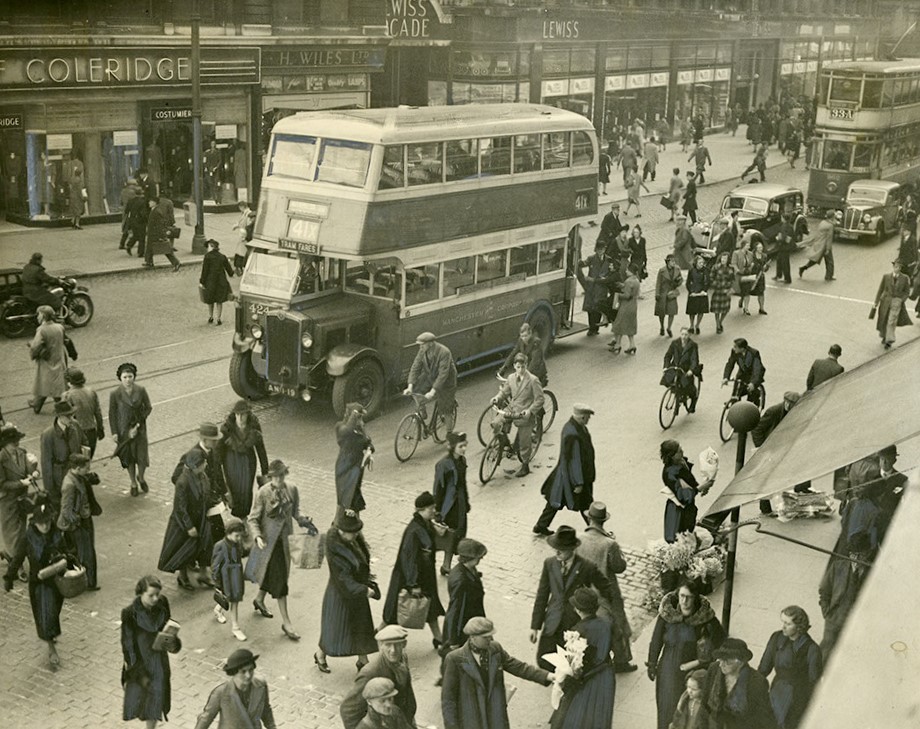
A typical busy day in Manchester in the 1930s: both bus and tram head up Market Street towards Piccadilly
1930 The Road Traffic Act introduces licensing systems for services, vehicles, drivers and conductors.
1930 Manchester Corporation’s 53 tram service is converted to operation by double-deck buses (6 April). This is the first main tramway track to be abandoned.
1930 Manchester Corporation decides to adopt diesel engines rather than petrol engines for buses.
1930 Manchester Corporation opens Princess Road bus garage with accommodation for 60 buses (15 April).
1930 SLT introduces first trolleybus route (29 July).
1930 London Midland and Scottish Railway (LMS) and London North Eastern Railway (LNER) acquire half the shares in North Western Road Car Company.
1930 First tramway route abandoned by Rochdale Corporation, to Littleborough (October).
1930 North Western opens Altrincham Bus Station.
1930 Rochdale Corporation makes the decision to convert tram routes to buses.
1930 Leigh Corporation’s Holden Road garage opens and due to its height, low height 13’6” high buses have to be used (13 November).
1930 JR Tognarelli (operator of express services from Bolton to Manchester) taken over by Bolton, Manchester, Oldham and Salford corporations and LUT (December).
1931 First part of Parker Street bus station opened in Manchester city centre (Piccadilly).
1931 Last trams run by Wigan Corporation (28 March).
1931 Trolleybuses withdrawn by Ramsbottom UDC (31 March).
1931 Cheadle to Gatley tram service abandoned – the first withdrawal by Stockport Corporation.
1931 Options considered regarding the formation of a joint transport board for Greater Manchester. Report published August 1933, but nothing comes of the proposals.
1931 Trolleybuses withdrawn by Wigan Corporation (31 October).
1931 Bury and Rochdale corporations adopt the diesel engine for buses.
1932 Cheap-travel day tickets are introduced by Manchester Corporation.
1932 Manchester Corporation’s Parrs Wood Garage extension opens.
1932 First diesel buses operated by Wigan Corporation.
1932 Ashton-under-Lyne Corporation Tramways becomes Ashton-under-Lyne Corporation Passenger Transport Department, one of the last to retain tramways in its name (April).
1932 Holt Brothers of Rochdale becomes Yelloway Motor Services Limited (April).
1932 Stockport Corporation opens Heaton Lane bus garage (28 July).
1932 Wigan Corporation introduces its first diesel engined buses (1 October).
1932 Rochdale Corporation runs its last electric tram, the last in Rochdale (10 November).
1933 Decision taken by Bury Corporation to abandon its tramway system (March).
1933 South Lancashire Transport (SLT) starts trolleybus operation on the Bolton to Leigh service.
1933 London Passenger Transport Board takes over all bus, trolleybus, tram and underground railway operations – and is watched closely by local operators.
1933 Salford Corporation introduces TIM ticket machines.
1933 Orr’s Motor Services of Little Lever purchased by Bolton, Salford and Bury corporations (25 June).
1933 SLT runs its last tram (16 December).
1934 Trafford Park Estates hands over its tramway operations to Manchester, Salford and Stretford corporations along with the power to operate other forms of transport in Trafford Park.
1934 Manchester’s Parker Street bus station is extended.
1934 First double deck buses are operated by Stockport Corporation.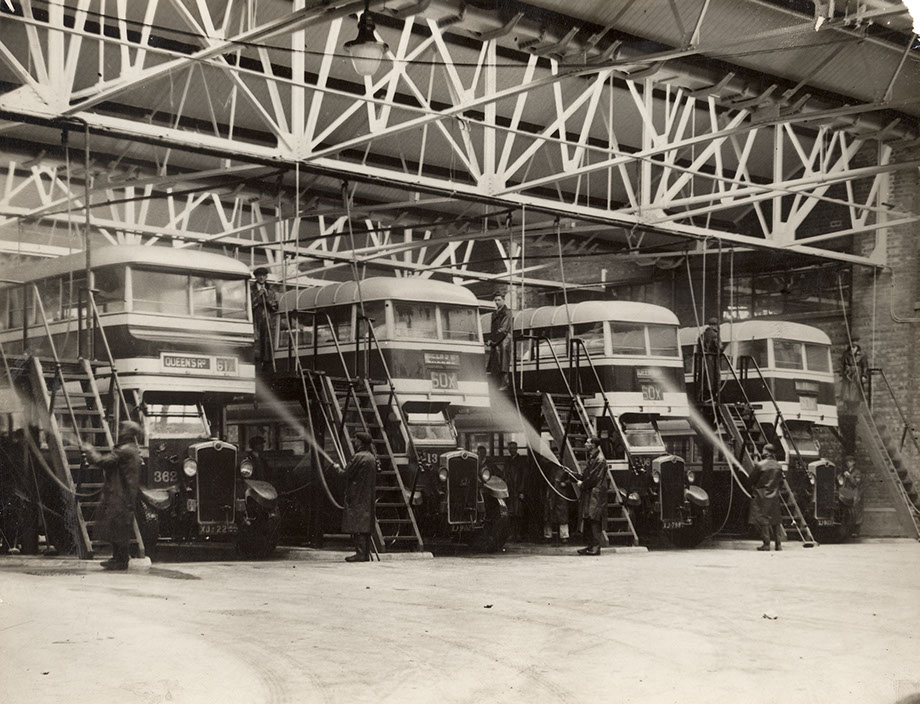
Buses being washed in Manchester Corporation's Queens Road Bus Garage (now the Lower Hall of the Museum of Transport, 1930s
1935 38 miles of tramway have now been abandoned by Manchester Corporation.
1935 Manchester Corporation’s Queen's Road bus garage extended further for motor bus operation (part of the Museum of Transport).
1935 SHMD applies for powers to operate trolleybuses but Ashton-under-Lyne and Manchester corporations run the services.
1936 First large double deck 6 wheel trolleybus introduced by Ashton-under-Lyne Corporation.
1936 Four new trolleybuses, operated by SLT but owned by Bolton Corporation, go into service to replace the remaining Bolton Corporation trams on the Bolton to Leigh service between Bolton and Four Lane Ends (29 March).
1936 Leigh, Manchester and Salford corporations now use 'TIM' ticket machines.
1937 Salford Corporation opens Victoria Bus Station (December).
1938 Rochdale Road trolleybus depot, with accommodation for 115 vehicles, opened by Manchester Corporation and its trolleybus system opens (1 March).
1938 Last trams operated by Ashton-under-Lyne Corporation on the Manchester to Ashton service (1 March). New trolleybus service starts serving Manchester, Ashton and Stalybridge.
1938 Manchester Ringway Airport opens (25 June).
1938 The trolleybus service from Hathershaw to Ashton-under-Lyne withdrawn by Ashton-under-Lyne Corporation and converted to motor bus operation.
1938 Oldham Corporation opens its new Central Omnibus Garage at Mumps.
1938 Manchester Corporation converts its Queens Road Depot to a bus garage.
1939 Manchester Corporation decides to abandon its remaining tramway system (February).
1939 Manchester Corporation’s Princess Road tram depot is converted to a bus garage.
1939 Second World War begins on 3rd September.
1939 Public transport used to evacuate children to "safe" areas (September).
1939 All tramway abandonment plans in Greater Manchester put on hold.
1939 Only one Oldham Corporation tram route remained: Waterhead to Manchester (a joint service between Oldham and Manchester corporations).
1939 During the Second World War, Bury reintroduces trams to part of the Whitefield service.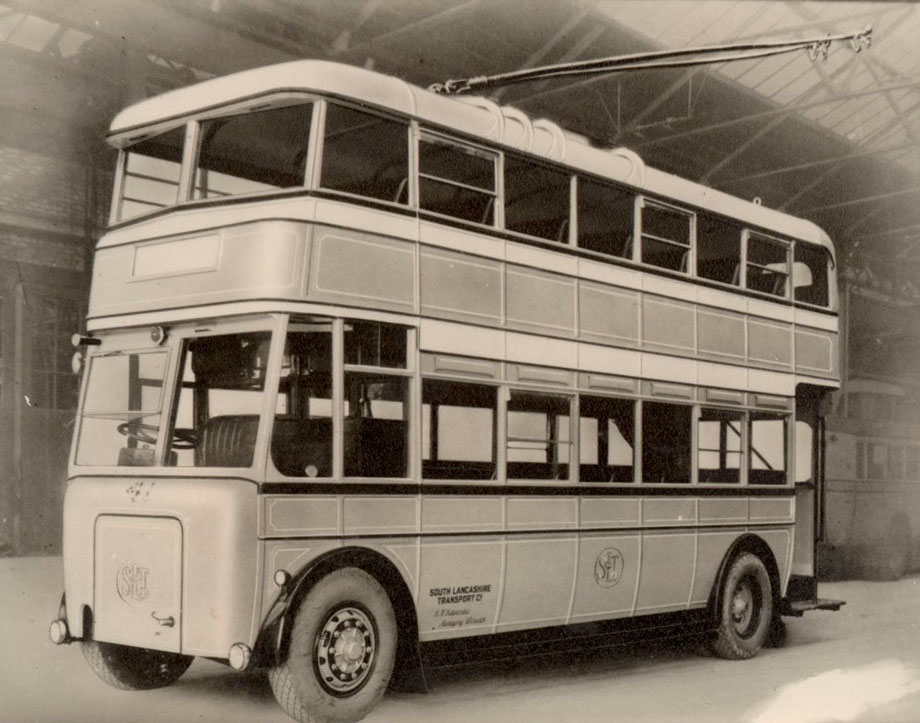
Newly delivered SLT trolleybus, seen at Atherton Works
1940 Manchester Blitz results in public transport services being unable to enter the city centre due to severe bomb damage (December).
1941 Manchester’s Parrs Wood garage taken over by Ministry of Aircraft Production for use as a munitions factory.
1941 90 motor buses loaned by Manchester Corporation to London Passenger Transport Board and 182 to other undertakings for the war period. Bolton Corporation loans 24 and North Western also loan buses to London.
1941 Manchester Corporation’s trolleybus network is extended to serve Moston and the A.V. Roe munitions factory instead of being used on the Hyde route.
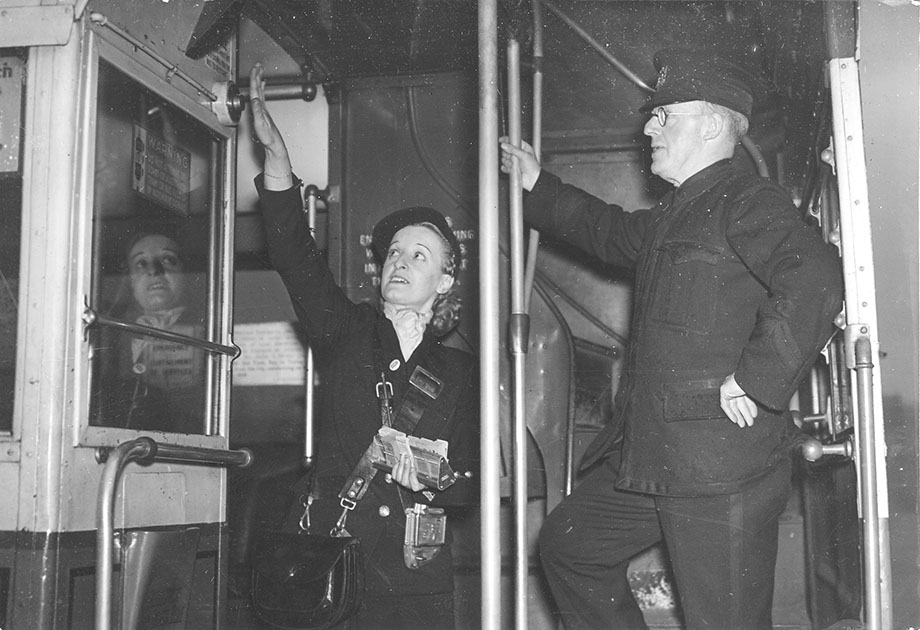
Conductress undergoing training in preparation for working on her own
1942 A portion of Manchester Corporation’s Northenden bus garage is taken over by the Ministry of Aircraft Production.
1942 Sites are used for the open-air parking of buses as a wartime measure to prevent the risk of damage to buses as a result of bombing of garages.
1942 Tilling and BAT arrangement is discontinued. North Western passes to BAT control in exchange for Tilling taking on Crosville.
1942 Bolton Corporation scraps Bell Punch system and introduces TIM ticket machines.
1944 Number of passengers carried annually by Manchester Corporation exceeds 400 million for the first time.
1944 The Yelloway Motor Services Rochdale to Manchester route is taken over by Manchester, Oldham and Rochdale corporations.
1944 First utility trolleybuses are obtained by Ashton-under-Lyne Corporation.
1944 Last tram to run over SLT tracks, operated by Bolton Corporation on the Walkden service (13 November).
1945 The Second World War ends in Europe on 8 May (VE Day) and in Japan on 15 August (VJ Day).
1945 By the end of the War, 167 women cleaners and mechanics have been employed by Manchester Corporation.
1945 1,591 conductresses are given notice of dismissal by Manchester Corporation in order for male employees returning from war service to resume duties.
1945 During the War, of the 2,372 employees (including 40 women) who had enlisted in H.M. Forces, 841 had lost their lives.
1945 Replacement of the remaining tramways recommences.
1945 Last SHMD trams run in service (May).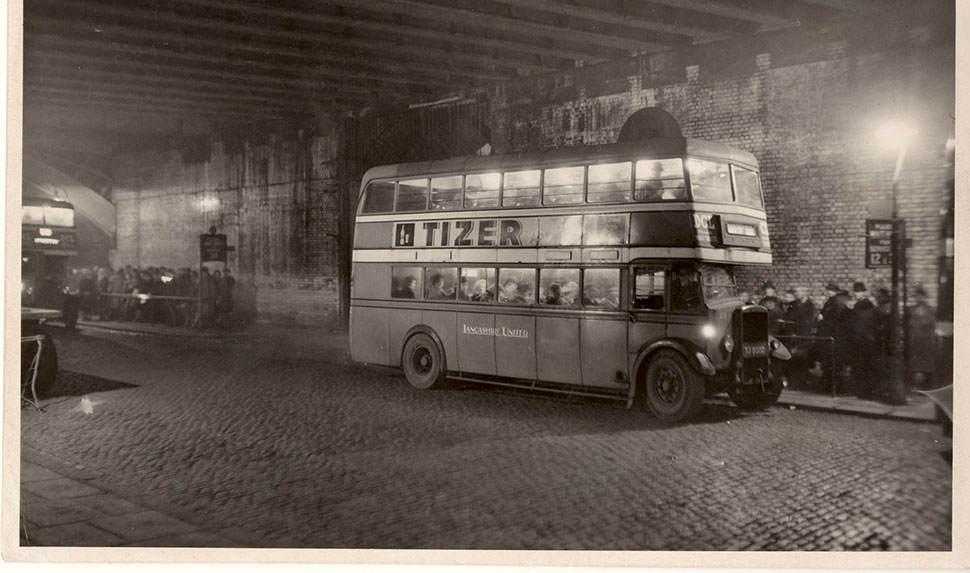
LUT buses in Greengate, Salford
